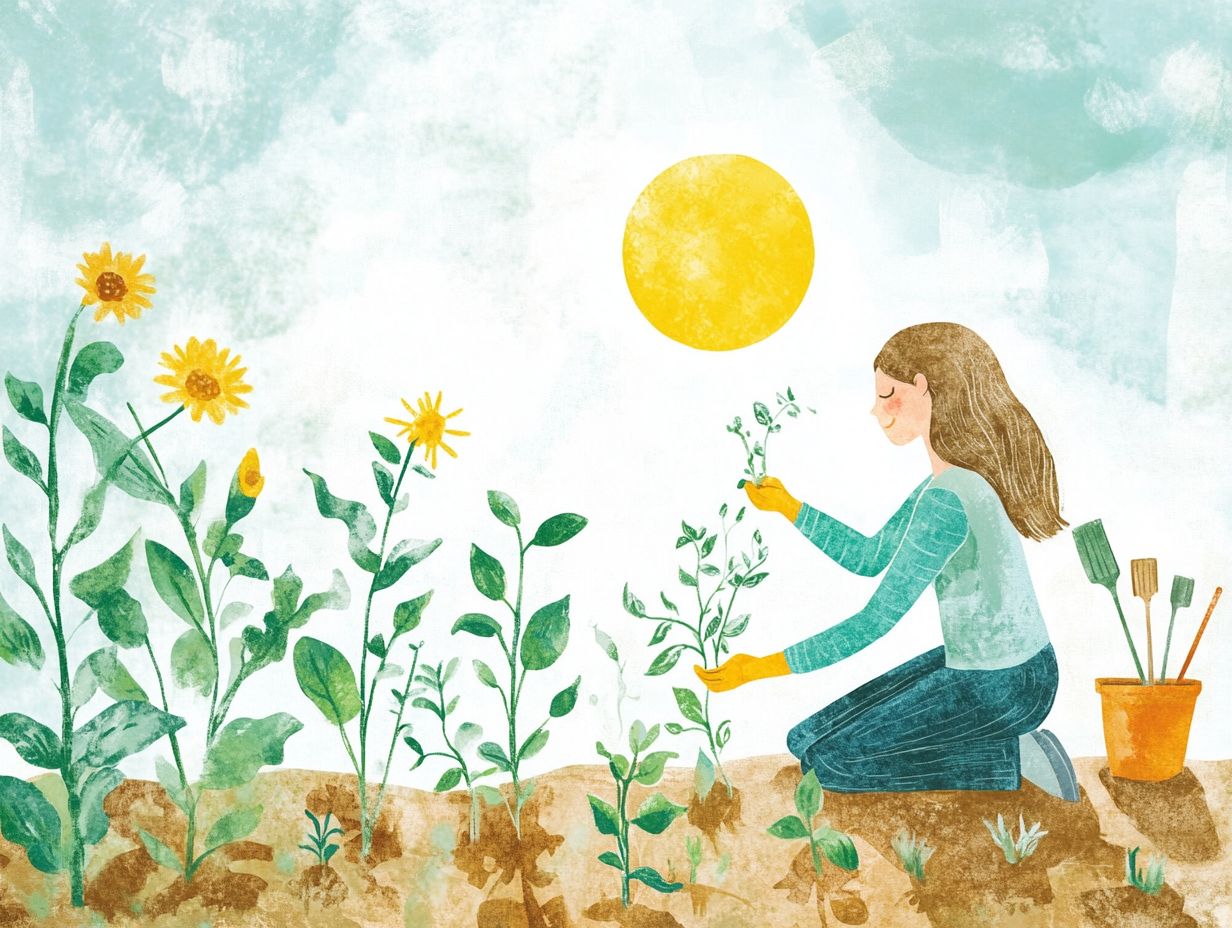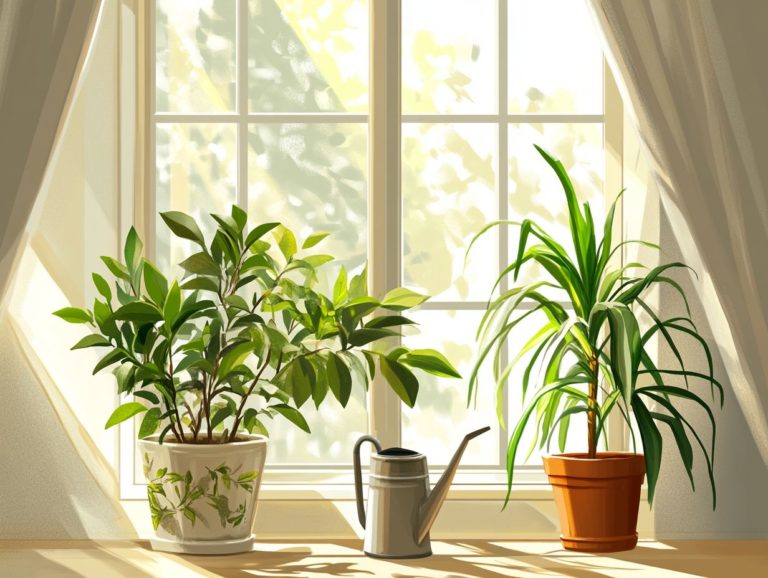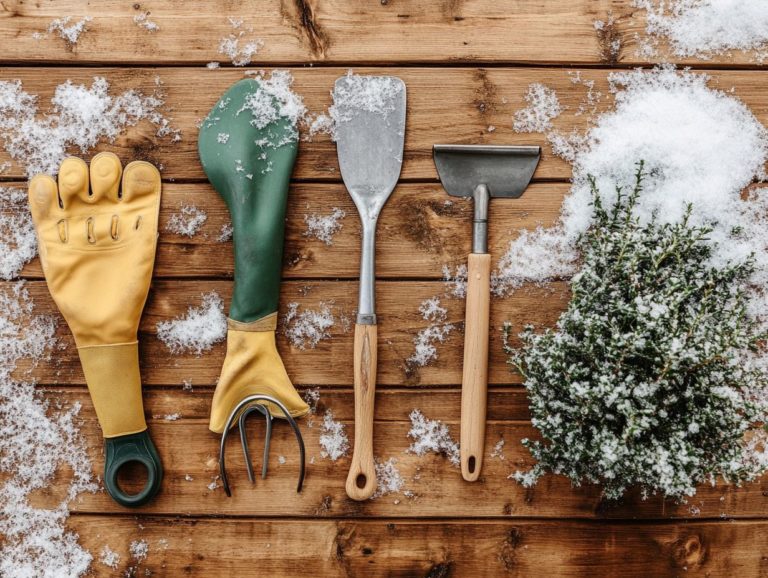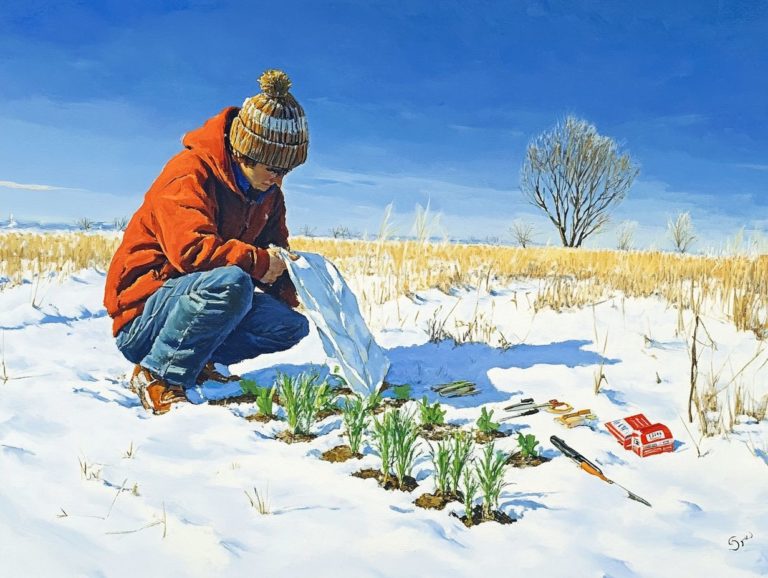How to Prepare Your Garden for Early Spring
As winter recedes and the promise of spring draws near, the thrill of gardening and nurturing your garden starts to awaken within you.
By preparing your garden early for spring, you lay the groundwork for a flourishing growing season and provide your plants with the optimal conditions to thrive.
Assessing winter damage, amending the soil, and selecting the right tools are essential steps in your early garden preparation.
Get ready to discover the amazing benefits of starting your gardening early! This guide will provide crucial steps to take and maintenance tips to ensure your garden flourishes throughout the growing season.
Contents
- Key Takeaways:
- Why Prepare Your Garden for Early Spring?
- Assessing Your Garden s Condition
- Tools and Supplies You Will Need
- Steps to Prepare Your Garden
- Maintaining Your Garden for the Rest of Spring
- Frequently Asked Questions
- Why is it important to prepare your garden for early spring?
- What are the steps to preparing your garden for early spring?
- When is the best time to start preparing your garden for early spring?
- Do I need to do anything special to prepare my garden for early spring if I live in a colder climate?
- What are some common mistakes to avoid when preparing your garden for early spring?
- Is it necessary to incorporate organic methods when preparing your garden for early spring?
Key Takeaways:

- Start preparing your garden early in spring for healthier plants and increased productivity in your vegetable garden.
- Before diving into spring gardening, check the soil condition and assess for winter damage.
- Stock up on essential gardening tools and supplies to ensure successful garden preparation. Clean, amend soil, and plant for early spring, maintaining your garden throughout for continued success.
Why Prepare Your Garden for Early Spring?
Preparing your garden for early spring is not just an option; it’s a pivotal step that can dramatically elevate the health and productivity of your plants throughout the growing season, especially for perennials. For detailed steps, check out this guide on preparing soil for early spring planting.
By dedicating time to essential tasks like soil preparation and tool organization you set the stage for a vibrant and thriving garden.
Early preparation facilitates a smoother planting process and allows you to evaluate your garden’s condition, including any winter damage that might have occurred. For those in colder areas, preparing your soil for spring by incorporating organic compost and mulch optimizes your garden for the promising season ahead.
Benefits of Early Preparation
The advantages of early preparation for your garden, including vegetable beds, extend beyond aesthetics; they are vital for the health and productivity of your plants during the essential spring growing season. For specific strategies, consider preparing your garden for the first frost.
Dedicating time to this proactive strategy helps cultivate stronger, healthier plants, leading to earlier harvests that delight your palate. For example, incorporating organic compost enriches the soil, improves its structure, and enhances water retention.
Getting a head start on planting facilitates superior pest control, allowing natural predators to establish themselves before pest populations escalate. Many seasoned gardeners find that using row covers for seedlings offers crucial protection and encourages faster growth, ultimately resulting in a bountiful crop that arrives ahead of schedule.
Assessing Your Garden s Condition
Assessing your garden’s condition is a crucial step in preparing for spring. This evaluation helps identify damage from winter, assess the health of your soil, and determine the most effective course of action for your plants. For detailed guidance, consider following essential steps to prepare your garden for winter and enhance your gardening strategy.
This proactive approach sets the stage for a thriving garden as the seasons change.
Checking for Winter Damage
Checking for winter damage is an essential part of evaluating your garden s health. It helps pinpoint which plants and perennials, such as hydrangeas and daylilies, may need pruning, cleaning, or even outright replacement.
During this inspection, scrutinize the foliage, bark, and roots of each plant closely. Look for signs of damage like browning leaves, broken branches, or patches of lifeless bark. Knowing the specific needs of your plants is vital.
After identifying trouble spots, proper pruning techniques will encourage new growth and help maintain the overall structure of your plants.
Cleaning up fallen debris and trimming away dead or damaged parts elevates your garden’s visual appeal and minimizes the risk of pests and diseases. This proactive approach fosters a healthier environment where your garden can truly thrive.
Soil Testing and Analysis

Soil testing and analysis are essential for understanding the health of your garden’s soil.
This knowledge allows you to make informed decisions about additions, such as adding compost or mulch to improve fertility and structure.
Start by collecting soil samples from various spots in your garden to ensure you capture an accurate snapshot of its overall condition. It’s important to dig down about six inches, clear away any debris, and place the soil into a clean container.
Once you ve gathered your samples, send them off to a laboratory for testing. This will yield valuable insights into pH levels, nutrient content, and any potential contaminants. Understanding these results is vital for maintaining soil health, as they will guide you in making precise amendments.
For example, if your soil leans toward acidity, adding lime can help raise the pH. A nitrogen deficiency can be remedied with aged manure or specialized fertilizers.
Nurturing your soil enhances plant growth and creates a thriving ecosystem for beneficial microorganisms.
Tools and Supplies You Will Need
Having the right tools can set you on the path to gardening success. By ensuring you have everything necessary, you can prepare, plant, and maintain your garden with remarkable efficiency throughout the season.
Essential Gardening Tools
Having essential gardening tools is crucial for your garden preparation and maintenance. These tools enable you to tackle everything from soil improvement to planting with ease and efficiency.
Equipping yourself with the right implements boosts your productivity and elevates your entire gardening experience. For instance, a sturdy spade is critical for digging and turning soil, while pruning shears are vital for shaping plants and encouraging healthy growth.
You should also consider investing in a reliable trowel for transplanting and a rake for clearing debris. Understanding the unique functions of these tools can streamline various gardening tasks.
Routine maintenance like cleaning and sharpening your tools after each use ensures they last longer and perform at their best. This way, you can enjoy the beauty of a thriving, well-tended garden for many seasons to come.
Recommended Supplies
In terms of gardening, you ll want to stock up on high-quality compost, mulch, and seeds each playing a crucial role in setting the stage for a flourishing growing season filled with vibrant blooms and healthy vegetables.
Don’t stop there; tools like trowels, pruners, and watering cans are your best allies in maintaining the health of your garden. High-quality compost enriches your soil, delivering vital nutrients that encourage robust plant growth.
Meanwhile, mulch works its magic by retaining moisture and suppressing weeds, creating a welcoming environment for your plants. And let s not forget the seeds they’re the very foundation of your garden, leading the way to lush foliage and vibrant blooms.
To elevate your gardening experience further, explore resources from platforms like Joe Gardener and the Smart Start Garden Planner. These offer curated recommendations and expert insights that cater to both novice gardeners and seasoned pros alike.
Steps to Prepare Your Garden
To prepare your garden for success, follow these systematic steps:
- Clean and clear the area.
- Amend the soil.
- Plant your seeds or seedlings, ensuring they have a healthy start this spring.
With this thoughtful approach, your garden will thrive beautifully.
Cleaning and Clearing

Cleaning your garden of winter debris is an essential first step. It enhances appearance and promotes plant health by reducing pests and disease risks.
Inspect your garden to spot lingering weeds or dead plants that can hinder growth. Raking, pruning, and composting will greatly improve your garden s environment.
Check the soil condition. Amending it can create a strong foundation for thriving plants.
A clean garden attracts beneficial insects and prevents disease spread, fostering a healthier ecosystem.
Amending the Soil
Enhance your soil with high-quality compost and mulch. This boosts nutrient content, structure, and overall health, which are vital for your garden’s success.
Adding organic materials creates a rich environment that supports beneficial microorganisms and improves water retention. Start by assessing your soil quality with a simple pH test to identify any issues.
Spread compost evenly over the soil and till it in deeply for thorough integration. Then, add a layer of mulch to conserve moisture and suppress weeds.
By adopting this approach, you can cultivate a thriving ecosystem that nurtures healthy plants.
Planting and Sowing
Planting seeds marks the start of the growing season! It s your chance for a fruitful harvest of vegetables and stunning flowers.
Know the ideal timing for sowing. Some seeds thrive in cooler weather, while others prefer warmth.
For example, plant peas and spinach early for a quick harvest. For tomatoes and peppers, wait until after the last frost.
Spacing is key. Giving carrots room to grow prevents overcrowding, while zinnias need space to bloom beautifully.
Depth matters too. Tiny seeds like lettuce should be just below the surface, but larger seeds like beans need to be planted deeper.
Maintaining Your Garden for the Rest of Spring
To ensure your garden flourishes during the vibrant spring season, embrace a consistent maintenance routine. Regular watering, thoughtful pruning, and attentive seasonal care are vital for optimal plant health.
By following these practices, you ll cultivate a thriving oasis showcasing spring s best beauty. Start today and watch your garden come to life!
Tips for Continued Success
Implementing essential tips for continued success in your garden will enable you to cultivate a thriving environment where your plants can truly flourish throughout the growing season.
First and foremost, mastering effective watering techniques is vital. It s not just about the quantity of water you apply; the timing and method are equally important. A deep soak in the early morning encourages robust root growth. Additionally, avoiding overhead watering minimizes the risk of fungal infections.
Adding helpful insects and using natural repellents can significantly boost your pest control efforts. This approach fosters a sustainable method for maintaining garden health.
You can enrich your gardening knowledge by exploring online courses or joining local gardening clubs. These resources offer valuable insights and support a community for your ongoing education.
Frequently Asked Questions

Why is it important to prepare your garden for early spring?
Preparing your garden for early spring is crucial because it sets the foundation for a successful growing season. To enhance your efforts, consider how to start your winter gardening early. Properly preparing the soil ensures that your plants have the best possible start, leading to healthy and vibrant growth.
What are the steps to preparing your garden for early spring?
The steps include:
- Cleaning up any debris and removing dead plants from the previous season.
- Testing your soil and amending it with necessary nutrients.
- Planting cool-season crops.
- Adding mulch to retain moisture and control weeds.
- Fertilizing and watering as needed.
When is the best time to start preparing your garden for early spring?
The best time to prepare your garden is late winter, typically around February or March. For detailed steps on how to prepare your garden for fall, this timing allows you to complete necessary tasks before the growing season begins.
Do I need to do anything special to prepare my garden for early spring if I live in a colder climate?
If you live in a colder climate, you ll want to take extra steps to protect your plants. Consider adding additional mulch to shield them from frost, using cold frames or row covers for delicate plants, and starting some plants indoors before transplanting them outside.
What are some common mistakes to avoid when preparing your garden for early spring?
Avoid these common mistakes:
- Starting too early.
- Over-watering or fertilizing.
- Neglecting to test your soil.
- Failing to remove diseased or pest-infested plants.
It s also important to follow the recommended planting times for your specific location and climate.
Is it necessary to incorporate organic methods when preparing your garden for early spring?
While not strictly necessary, using organic methods can yield numerous benefits. Organic fertilizers and amendments can improve soil health and promote beneficial microorganisms. Moreover, avoiding harsh chemicals creates a safer environment for your plants and family.
Get started on transforming your garden today!






